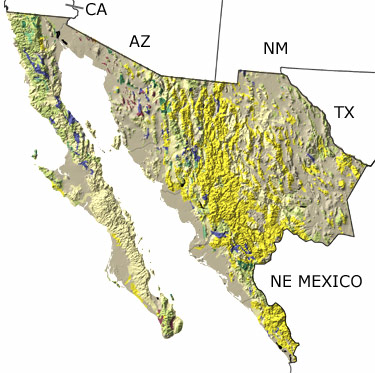Northwest region, Mexico
|
|
|||||||||||||||||||||||||||||||||||||||||||||||||||||||||||||
Paleontology and geology
The Precambrian: Most of Northwestern Mexico did not exist in the Precambrian, except for the northern part of this region, which was near the edge of the ancient North American continent (Laurentia). This area contains ~1.8 Ga metamorphic rocks, the oldest rocks in Mexico, and was covered by shallow seas. The sandstones, mudstones, and limestones deposited in the sea preserve fossils of stromatolites and some of the earliest multicellular animals. Some Precambrian deposits may have formed elsewhere and been moved to their present location. Geologists continue to study how and when they formed.
The Paleozoic: During the Paleozoic, the edge of the continent lay to the north, and shallow to deep seas of the continental shelf and slope extended out into the ocean over this region. In the early Paleozoic, other parts that would eventually be added to the region existed as volcanic islands out in the ocean or had not formed yet. By the middle of this era, the area experienced some tectonic activity as the supercontinent Pangea formed in the east and volcanic islands approached in the west. Some areas dropped down into basins, while others rose up into highlands, and many rocks were folded, faulted, and altered. The newly formed land was covered in different kinds of plants, while the shallow to deep seas were home to a wide variety of animals.
The Mesozoic: In the Mesozoic, the supercontinent Pangea rifted apart and subduction began along the newly formed continental margin running down central Mexico. This tectonic activity generated substantial volcanism and added islands and slices of oceanic crust to the Northwestern Region. It also pushed up some areas and dropped others down into basins. Many different invertebrates and vertebrates thrived in the shallow to deep seas between exposed areas of land, where freshwater invertebrates, fish, small reptiles, and dinosaurs lived in lakes, swamps, and forests. By the end of the era, the last pieces of land were added to the continent, and many rocks were folded, faulted, and altered.
The Cenozoic: Subduction ended in the Cenozoic, and the oceanic and continental plates in the western part of this region began to slide past each other. The crust thinned and pulled apart, forming basins and mountain ranges, and opening the Gulf of California. Volcanic eruptions continued to spread ash and lava over the region. The seas were filled with many invertebrates and vertebrates, which are preserved in deposits exposed along the coasts. On land, lakes, savannas, and forests were home to amphibians, reptiles, birds, and mammals. By the end of the era, the climate became drier and deserts developed in the region.
Links to more on Northwest region paleontology
ResourcesSocieties and Clubs (showing 1 of 1 listings)
Sociedad Mexicana de Paleontologia A.C.: Information on the organization's history, membership, publications, etc.
Colleges and Universities (showing 1 of 1 listings)
Northern Arizona State's MS degree in Environmental Sciences & Policy with an emphasis in Paleoenvironmental Sciences: Paleoenvironmental scientists investigate the recent geological past to learn about natural and human-caused environmental and climatic changes. In this interdisciplinary curricular track, you’ll develop broad competence in earth and environmental sciences, while specializing in an analytical technique used to reconstruct long-term environmental variability.
History of Paleontology (showing 2 of 2 listings)
The Importance of Fossils: A short history of paleontology in Mexico written in May 2000.
Dinosaurios en México: A history of dinosaur discoveries in Mexico.
General Reference (showing 3 of 6 listings)
Dinosaurios Mexicanos: A 1998 description of Mexican dinosaur discoveries, with a focus on Coahuila.
Equinodermos fósiles de México: An examination of the known fossil echinoderms from Mexico.
Fossil Triassic plants of Sonora, Mexico: A discussion of fossil plants from the Santa Clara Formation accompanied by photographs.

